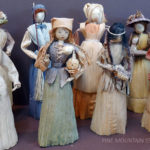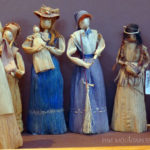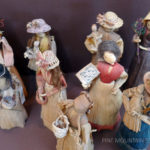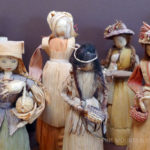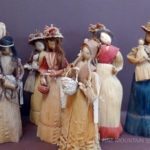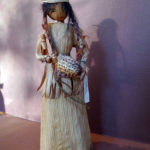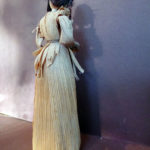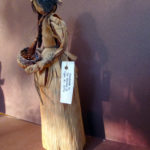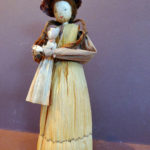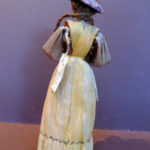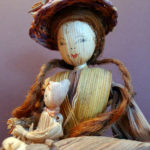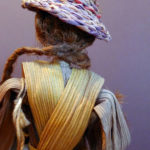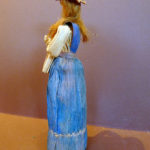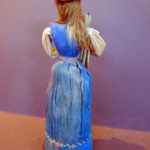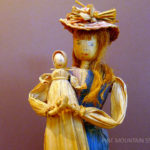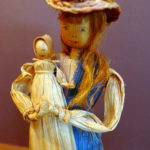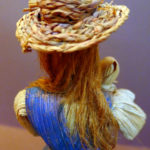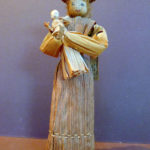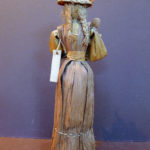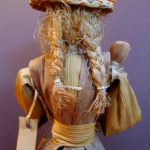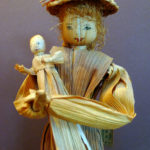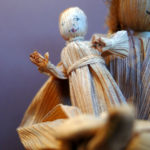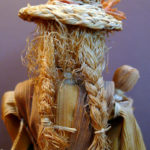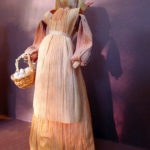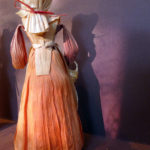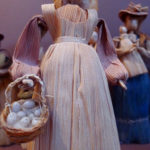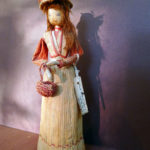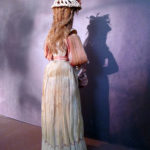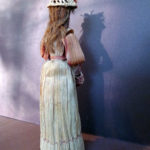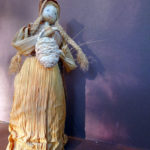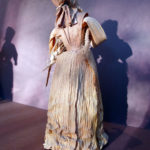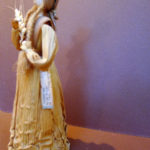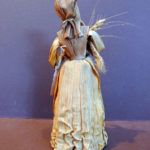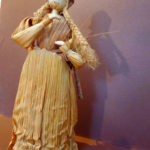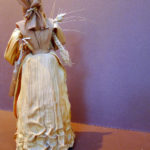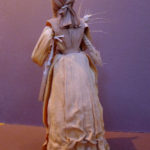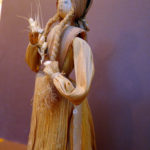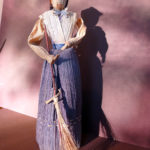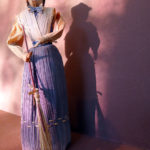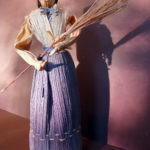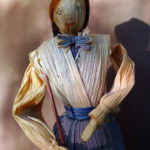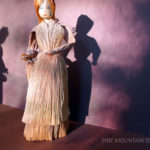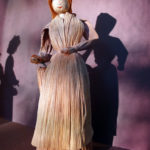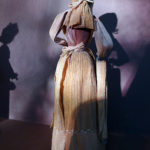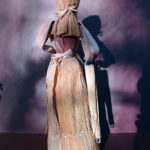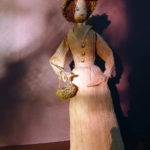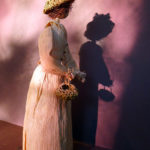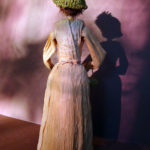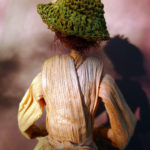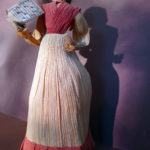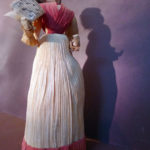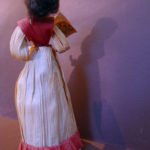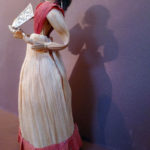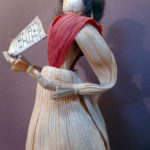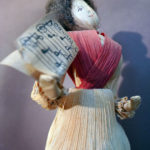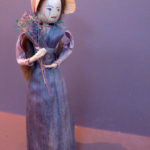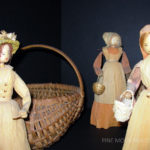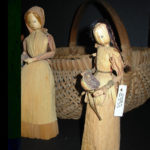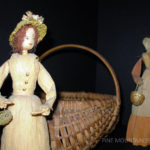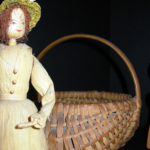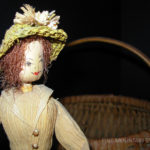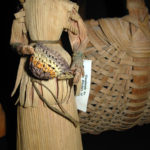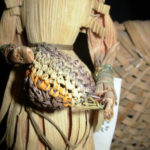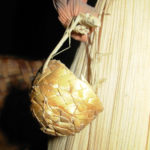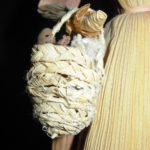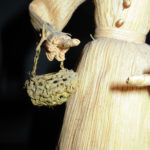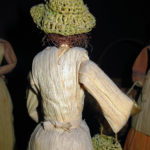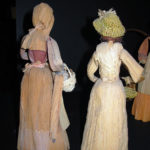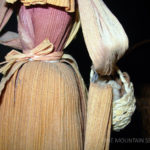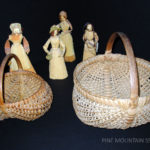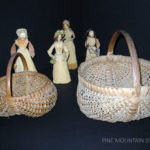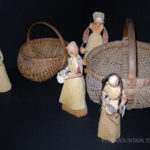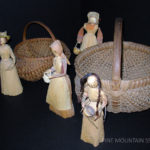Pine Mountain Settlement School
Series 15: ARTS AND CRAFTS
Corn Husk Dolls (Cornshuck Dolls)
Ritchie Family Dollmakers, 1940s-1980s
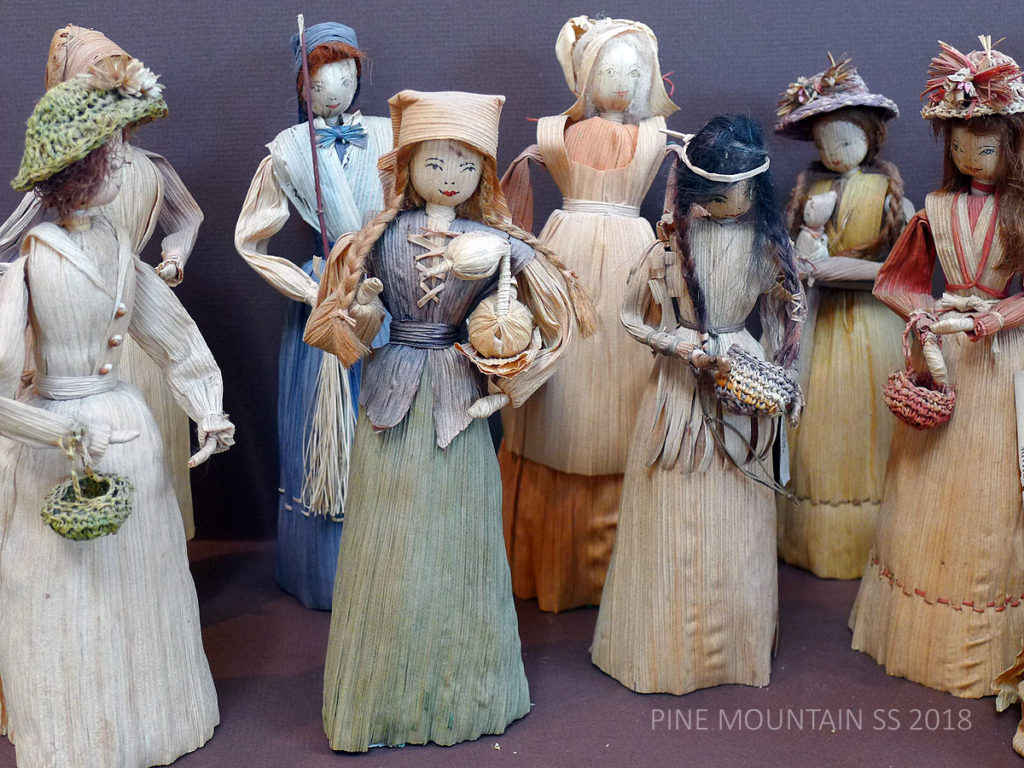
Corn Husk Dolls (Cornshuck Dolls), from a privately held collection of 14 dolls. [P1150683.jpg]
ARTS AND CRAFTS Corn Husk Dolls (Cornshuck Dolls)
Created by the Ritchie Family 1940s-1980s
TAGS: object collections, cornshuck dolls, corn husk craft, dolls, Kitty Ritchie Singleton, May Ritchie Deschamps, Mallie Ritchie, Jewel Ritchie Robinson, Ritchie family, Viper Kentucky, baskets, hickory-split baskets, Smithsonian Institution, poppets
All the dolls in the displayed collection were created by women members of the Ritchie family of Viper, Kentucky. May, Kitty, Mallie, and Jewel were the most prolific of the Ritchie dollmakers in the 1940s through the early 1980s. May Ritchie and Kitty Ritchie were students 1 at Pine Mountain Settlement as were several other Ritchie children, including Raymond and Una. Other Ritchie children went to Hindman, and Jean, the youngest, was educated in the local public school system at Viper.
The most famous of the sisters and the youngest sister, Jean Ritchie, most likely knew the craft and writes about making “poppets,” (the name given to hand-made dolls), in her book, Singing Family of the Cumberlands (1955), illus. by Maurice Sendak.
The various corn husk/cornshuck dolls of the Ritchie sisters have been exhibited in major museums throughout the country and the work of May Ritchie is held in the Smithsonian Museum in Washington, DC. The works of the other sisters also reside in many folk-life collections, museums, and private collections. The dolls in this collection are part of a private collection of Ritchie family corn husk dolls.
Corn Husk Dolls: THE ARTISTS
It is often asked who created which doll and if the makers can be identified by the style of the doll. The answer is “yes” — sort of. The sisters themselves described their distinctive styles in a news article distributed by Associated Press in the 1970s when they were invited to Washington to demonstrate their craft. As they tell it, each doll carries markers of its creator. For example, Kitty Ritchie (Singleton) is known for her “goose girl” seen above in the center of the photograph above. She is the doll with the green skirt and goose under her arm. Jewel Ritchie (Robinson) is known for her mother and daughter pairs. and Mallie Ritchie, has a style more like Shaker-like in which the cornshuck dolls are made with few embellishments. Further, each of the dolls has its own facial character and the face detailing can also suggest which Ritchie made the doll. How lips and eyes are drawn in ink, often can reveal the artist. Yet, there is one characteristic the dolls frequently share. Most of the dolls are red-heads. This preference is not lost on those who know the many beautiful red-heads in the Ritchie family.
Corn Husk Dolls: CONSTRUCTION
Almost all the dolls are approximately 8″ – 8.5″ tall, and are limited somewhat by the size of the husks. The dolls in this display have not retained much of the intensity of the original aniline dyes used to color the husk garments, baskets, and hats. Generally, the corn husks were purchased in their natural state and then dyed with synthetic dyes, such as RIT. Some dyes have been more stable than others, depending on their exposure to light. The later originals are often more vibrant with color, as are those sheltered from harsh sunlight.
Interestingly, the husks used in most of the Ritchie doll’s construction were not from local mountain corn harvests but came from California where there was a ready supply of tamale husks that are sturdier, more uniform. The cleaner and sturdier husks also take the commercial dyes well and are dyed before assembling. Many in the above collection have now mellowed from their more vibrant and original state. The brilliant blue dress of the one doll is a later re-working of the faded earlier dye.
Hats and baskets are often crocheted or woven with a flat grass or plant stems. Interior wire makes the arms of each doll somewhat flexible. The head is a husk pulled tightly around a hard ball of cotton or tissue. One of the Ritchie sisters, Jewel, once remarked that she had “used a mattress stuffing their heads with cotton.”
* Some details are based on an Associated Press article in the PMSS Archive, n.d.
GALLERY I
- Ritchie Family, Viper, KY. Group. P1150703
- Ritchie Family, Viper, KY. Group P1150750
- Ritchie Family, Viper, KY. Group P1150686
- Ritchie Family, Viper, KY. Group P1150685
- Ritchie Family, Viper, KY. Group P1150684
- Ritchie Family, Viper, KY. 8″ P1150695
- Ritchie Family, Viper, KY. 8″ P1150696
- Ritchie Family, Viper, KY. 8″ P1150697
- Ritchie Family, Viper, KY. 8.5″ P1150733
- Ritchie Family, Viper, KY. 8.5″ P1150735
- Ritchie Family, Viper, KY. P1150734
- Ritchie Family, Viper, KY. P1150736
- Ritchie Family, Viper, KY. 8.5″ P1150740
- Ritchie Family, Viper, KY. P1150741
- Ritchie Family, Viper, KY. P1150739
- Ritchie Family, Viper, KY. P1150737
- Ritchie Family, Viper, KY. P1150742
- Ritchie Family, Viper, KY. 8.5″ P1150727
- Ritchie Family, Viper, KY. 8.5″ P1150730
- Ritchie Family, Viper, KY. P1150731
- Ritchie Family, Viper, KY. P1150728
- Ritchie Family, Viper, KY. P1150729
- Ritchie Family, Viper, KY. P1150732
- Ritchie Family, Viper, KY. 8.5″ P1150690
- Ritchie Family, Viper, KY. 8.5″ P1150691
- Ritchie Family, Viper, KY. P1150748
- Ritchie Family, Viper, KY. 8.5″ P1150692
- Ritchie Family, Viper, KY. 8.5″ P1150693
- Ritchie Family, Viper, KY. P1150694
- Ritchie Family, Viper, KY. 8″ P1150699
- Ritchie Family, Viper, KY. 8″ P1150700
- Ritchie Family, Viper, KY. 8″ P1150723
- Ritchie Family, Viper, KY. 8″ P1150726
- Ritchie Family, Viper, KY. 8″ P1150721
- Ritchie Family, Viper, KY. 8″ P1150724
- Ritchie Family, Viper, KY. P1150725
- Ritchie Family, Viper, KY. P1150722
- Ritchie Family, Viper, KY. 8.5″ P1150711
- Ritchie Family, Viper, KY. 8.5″ P1150712
- Ritchie Family, Viper, KY. 8.5″ P1150714
- Ritchie Family, Viper, KY. P1150713
- Ritchie Family, Viper, KY. 8.5″ P1150701
- Ritchie Family, Viper, KY. 8.5″ P1150702
- Ritchie Family, Viper, KY. 8.5″ P1150703
- Ritchie Family, Viper, KY. 8.5″ P1150704
- Ritchie Family, Viper, KY. 8.5″ P1150706
- Ritchie Family, Viper, KY. 8.5″P1150707
- Ritchie Family, Viper, KY. 8.5″P1150708
- Ritchie Family, Viper, KY. P1150710
- Ritchie Family, Viper, KY. 8.75″ P1150715
- Ritchie Family, Viper, KY. 8.75″ P1150716
- Ritchie Family, Viper, KY. 8.75″ P1150720
- Ritchie Family, Viper, KY. 8.75″ P1150718
- Ritchie Family, Viper, KY. P1150719
- Ritchie Family, Viper, KY. P1150717
- Ritchie Family, Viper, KY. 9″ P1150743
- Ritchie Family, Viper, KY. 9″ P1150744
GALLERY II: Corn Husk Dolls and Hickory Split Baskets
- Ritchie family crafts. [dolls_baskets_005.jpg]
- Ritchie family crafts. [dolls_baskets_006.jpg]
- Ritchie family crafts. [dolls_baskets_007.jpg]
- Ritchie family crafts. [dolls_baskets_008.jpg]
- Ritchie family crafts. [dolls_baskets_009.jpg]
- Ritchie family crafts. [dolls_baskets_010.jpg]
- Ritchie family crafts. [dolls_baskets_011.jpg]
- Ritchie family crafts. [dolls_baskets_012.jpg]
- Ritchie family crafts. [dolls_baskets_013.jpg]
- Ritchie family crafts. [dolls_baskets_014.jpg]
- Ritchie family crafts. [dolls_baskets_015.jpg]
- Ritchie family crafts. [dolls_baskets_016.jpg]
- Ritchie family crafts. [dolls_baskets_017.jpg]
- Ritchie family crafts. [dolls_baskets_018.jpg]
- Ritchie family crafts. [dolls_baskets_002.jpg]
- Ritchie family crafts. [dolls_baskets_003.jpg]
- Ritchie family crafts. [dolls_baskets_004.jpg]
See Also:
KITTY RITCHIE Biography
MAY RITCHIE Biography
PUBLICATIONS RELATED Corn Husk Crafts
ARTS AND CRAFTS at PMSS Guide
ARTS AND CRAFTS Overview

